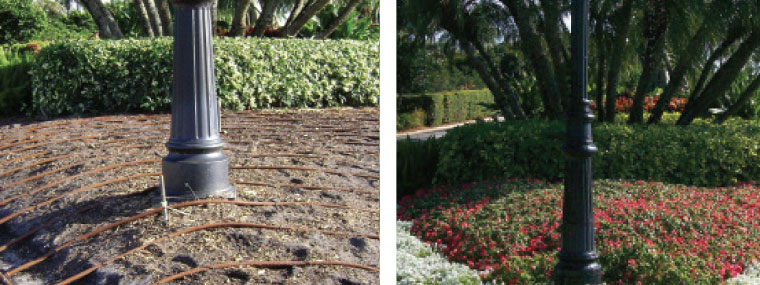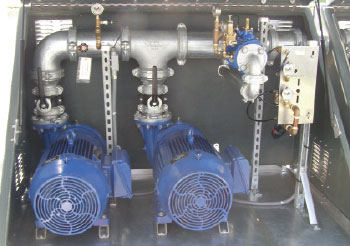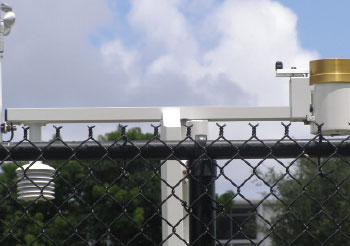
There Is No Such Thing as a Free Lunch!
What are You Currently Paying for Your Irrigation Water?
by Tom Balling / Published December 2014

The big misperception in Florida is that our lake and well water is free. We have all heard the old saying “there is no such thing as a free lunch,” and it is true in this case as well. While many communities may not be paying a utility or a municipality for each gallon that they draw from their lakes and wells, there most definitely is a cost. If communities did have to pay by the gallon, don’t you think they would focus more on making sure that every drop counted? If you want to know how expensive “free water” can be, we need to look no farther than to our neighbors in Atlanta, Georgia, or to Southern California, and ask them how much it cost when the lakes and wells dried up and the tap was turned off. Each city that was caught without a back-up plan and with no quick fixes available had to take immediate action, and irrigation of the landscape was all but completely banned. In many cases, the landscapes were devastated.
 So why does a state like Florida that averages between 40–60 inches of rainfall per year need to be concerned about water conservation? The fact is most of south Florida receives 50-plus inches of rain per year. The problem is that the majority of it happens in a five-month period. The challenge is delivering irrigation to our landscapes 12 months per year when 70 percent of our precipitation occurs between June to October. What we have in essence is a timing and storage issue, and I will save the storage question for another day.
So why does a state like Florida that averages between 40–60 inches of rainfall per year need to be concerned about water conservation? The fact is most of south Florida receives 50-plus inches of rain per year. The problem is that the majority of it happens in a five-month period. The challenge is delivering irrigation to our landscapes 12 months per year when 70 percent of our precipitation occurs between June to October. What we have in essence is a timing and storage issue, and I will save the storage question for another day.
According to South Florida Water Management, outdoor irrigation accounts for approximately 50 percent of all water use in our state. When you add in reclaimed water use, this percentage goes up even higher. Let’s face it, our south Florida green spaces and tropical plants are beloved in many of our community associations, and it takes water to keep them beautiful and healthy.
 The reality is that for the last several years south Florida has not endured a severe drought, and surface water, lakes, and wells in most areas have remained viable. But what happens when the next severe drought does come, water restrictions do get imposed, and water is scarce? The short answer is that our beautiful, lush, green landscape will feel the brunt of a water shortage. And the communities with 25–30 year-old, inefficient, irrigation system infrastructures will most certainly experience turf and plant losses during a severe drought.
The reality is that for the last several years south Florida has not endured a severe drought, and surface water, lakes, and wells in most areas have remained viable. But what happens when the next severe drought does come, water restrictions do get imposed, and water is scarce? The short answer is that our beautiful, lush, green landscape will feel the brunt of a water shortage. And the communities with 25–30 year-old, inefficient, irrigation system infrastructures will most certainly experience turf and plant losses during a severe drought.
Many residential communities throughout south Florida have realized that the “band-aid” approach to maintaining their old irrigation system is getting more expensive and less effective. And some of the larger communities, whose systems are in the worst condition, have already been mandated to retrofit their system or risk losing their South Florida Water Management use permit. Antiquated irrigation systems also generate hidden costs through improper watering, as they overwater in some areas and underwater in others, causing stress, which mandates herbicide, pesticide, fungicide, and additional fertilizers, not to mention turf and plant material replacement.
The biggest barriers related to the idea of upgrading or retrofitting aging irrigation systems are cost and the impact on the community residents. After all, most irrigation components are out of sight and, therefore, out of mind. While it is true that the cost of a complete system overhaul may seem high, the data suggests that a new irrigation system installed with properly-designed VFD (variable-frequency drive) pump stations, central control monitoring, efficient nozzles and heads, and soil moisture sensors can reduce water consumption by 70 percent and energy costs by 50 percent. Not to mention that in case of a severe drought, communities with central control irrigation systems are much more likely to get a variance from mandatory water restrictions imposed by the South Florida Water Management.
A “smart” irrigation system will also reduce the labor required to operate and maintain it after the installation. With today’s systems, the once common “wet check” (the process of turning on each zone to visually check) is all but a thing of the past. With central controlled systems, the concept of turning on each zone to watch 90 percent of them working properly is antiquated and unnecessary. Today’s modern systems are managed through exception, that is by matching pre-programmed flow rates and run times to what actually occurred in the field. The irrigation technician is only looking for the 10 percent of the system that requires attention. In some cases, labor costs can be reduced by 80 percent for irrigation maintenance. With properly installed central control, what once took four, five, or more irrigation technicians can now be accomplished with one or two.
If your community is nearing the time for replacement of its irrigation system, plan now by consulting with a design professional and experienced, licensed, irrigation contractor. Together they will evaluate your needs, work on an efficient design, formulate a budget for construction, and calculate your estimated water, energy, and maintenance savings. Remember, it is everyone’s job to conserve our surface water, and there is no such thing as a free lunch or free water!

